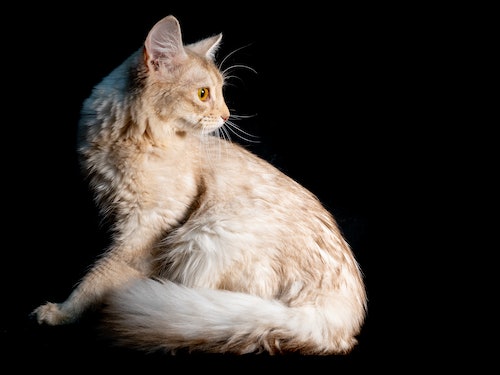We aren’t the only ones in need of safe sex. Depending on whom you ask, there’s no such thing as too many cats. Despite this, a population boom does quite a bit of damage.
Free-roaming kitties are responsible for the in the U. S. , which translates to two-thirds of all bird deaths annually.
An unchecked cat population also means shelters crowded with abandoned kittens, where the unadopted may ultimately face euthanasia. A common, effective solution is or TNR. In reality, this solution is more than three simple steps.
It requires capturing, anesthetizing, performing invasive surgery, recovering, and releasing cats. It also can’t be performed by just anyone — it must be a veterinarian, vastly reducing the pool of eligible helpers. But researchers have tapped into what may be a game changer for controlling the free-roaming cat population, one that may be far easier than TNR.
In fact, it could be as simple as a one-time injection. A in the journal demonstrates a proof-of-concept for this gloriously simple spay tactic that could make cat population control less painful for everyone involved — most of all the kitties. From mice to cats Conservationists at the Cincinnati Zoo and Botanical Garden teamed up with biologists and gene therapy experts from Massachusetts General Hospital, Harvard Medical School, and the University of Massachusetts Chan Medical School to test an injectable gene therapy that could serve as a long-acting contraceptive for female domestic cats.
However, that was not its intended purpose when it was developed. , a molecular biologist and associate professor at Harvard Medical School, and his lab discovered this contraceptive gene therapy. Pépin focuses primarily on female reproduction in humans, as well as ovarian physiology and cancer.
He was investigating a naturally produced hormone called anti-Müllerian hormone (AMH) which tempers the number of mature eggs that ovaries produce in the reproductive cycle. Their in the journal Proceeds of the National Academy of Sciences demonstrates that sufficiently high levels of AMH injected into mice inhibit egg maturation altogether, making it an effective, lifelong contraceptive. Seeking to continue their research, Pépin and his team learned the (for which Swanson is a scientific advisory board member) was offering grants for research on non-surgical spaying methods.
“There’s currently no solution that can scale to the size of that problem,” Pépin, a senior author on the new paper, tells . More than one way to spay a cat Neutering a cat isn’t a fancy-free affair. It’s an invasive surgery associated with an increased risk of infection and hemorrhaging.
Recovery from spay and neuter surgery also takes about 7 to 10 days, according to , co-author, and director of the Center for Conservation and Research of Endangered Wildlife at the Cincinnati Zoo. Cats returned to their natural habitat so soon after a major surgery run a higher risk of death by cars or other predators because they’re still recovering. Indoor cats may have their humans to dote on them with painkillers, but they still need at least a week to recover.
This injection would save cat owners a necessary major surgery on a creature they dearly love and would spare any affliction. “[For] most people, their pets are family,” Swanson tells . “They don’t want their animals to go through that if they don’t have to.
This might be a way to sterilize them without doing surgery. ” Hijacking a virus This injectable gene therapy is sort of like hijacking a car. It all starts with a virus (the car), which Pépin and his team use only as a means of spreading genetic information.
They empty the virus of all material associated with the sickness it might cause. In this case, they used adenovirus type 9. usually cause respiratory illnesses and conjunctivitis in humans, but as vectors, they’re with successful gene therapy delivery.
The Harvard and UMass contingent cloned the proper cat gene associated with producing AMH to fill the emptied viral vector. The cat genome, however, hadn’t been sequenced completely, so they reached across species to the dog genome to “fill in those blanks,” Pépin tells . The team then inserted this cloned gene into the emptied adenovirus cell.
The adenovirus cell has gone from being a car that spews a virus to a car that delivers AMH. Now, the gene therapy is ready for injection into cat muscle tissue. “There, it infects the muscle cells, then those muscle cells will produce the hormones,” Pépin continues.
This gene therapy allows the muscle cells to produce AMH, which is typically only created in the ovaries. Since the muscles now produce more AMH; eventually, enough will be produced to suppress egg maturation on follicles in the ovaries, preventing ovulation. “Essentially, we’re hijacking these mechanisms,” Pépin says.
A more humane cat control Before you get any ideas about one-time, irreversible contraceptives for humans, Pépin doesn’t intend to develop his method for that application. “Permanent contraception is not as big of a clinical need in humans,” he says. Humans have more use for a plethora of reversible contraceptives than free-roaming cats do.
However, this method would also work for dogs, both pets and free roamers. In that case, a version of this gene therapy for dogs would require the dog gene that produces AMH. Right now, the injections are not interchangeable between species.
Swanson says that we need more information before this method is scaled up into a widely practiced contraceptive. Pépin says he and the Michelson Found Animals Foundation will meet with the Food and Drug Administration later this year to discuss the next steps for rigorously testing this therapy. If it’s approved, the team has to find a way to scale up production with millions of injections.
There are, after all, a lot of cats out there. .
From: inverse
URL: https://www.inverse.com/health/cutting-edge-gene-therapy-revolutionize-birth-control-cats



